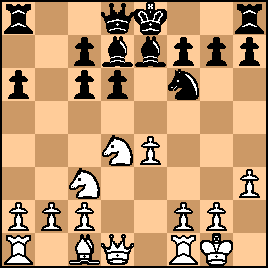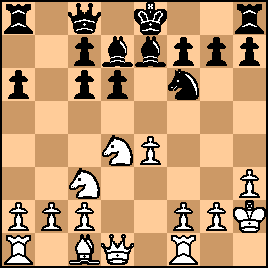| KEG: To this point in their respective careers, Marco had generally been cannon fodder for Janowski. In this game, Marco--generally a defensive/positional player with good endgame skills-- tried to flip the script and attempted to assume the attack. This resulted in an exciting but often sloppy game in which, after plenty of ups and downs, Janowski prevailed. After this game, Marco had better success against Janowski, winning three and losing five (with two draws). Janowski's win here left him, at the end of the 18th round, just a half-point behind Maroczy who bounced back from his 17th round loss to pass Pillsbury who was held to a draw this round by Tchigorin, who later won the replay against Pillsbury. With this win, Janowski had very real chances to win the tournament, losing this chance only because he lost his 19th round game against Mason allowing Maroczy and Pillsbury to take the top two places. Meanwhile, Marco kept Pillsbury from winning the tournament by drawing his 19th round game against the American and then winning the replay. Had Janowski won the balance of his games after this win over Marco, he would have been a clear candidate for a World Championship match against Lasker (many years before he actually took on Lasker), having won Monte Carlo 1901 and--after this tournament--winning Hanover 1902. Had all this occurred, perhaps Janowski would have avoided playing his 1902 match against Schlechter, in which he got decimated, and had the pleasure of getting annihilated by Lasker at this stage of his career. A review of the instant game leaves little doubt about how Janowski would have fared had he taken on Lasker in a match in 1902 or 1903. 1. e4 e5
2. Nf3 Nc6
3. Bb5 a6
4. Ba4 Nf6
5. 0-0 Be7
6. Nc3

click for larger viewA variation that was quite popular in 1902 that then went entirely out of fashion. Objectively, there is nothing wrong with the text despite the blocking of the White c-pawn. But, of course, 6. Re1 eventually relegated the text pretty much to the dustbins of history. 6... d6
6...b5, exploiting the potentially awkward placing of the White Knight on c3, has generally been more popular. But, yet again, the text is objectively fine and results in the kind of position that might be expected from a Steinitz-Defense-Deferred. 7. BxN+ bxB
8. d4 exd4
9. Nxd4 Bd7
The most usual line here. For whatever reason, 9...Bb7 has enjoyed little popularity. 10. h3
A novelty at the time, but--as in all such Lopez positions--perfectly sound. The idea, as usual, is to prevent Bg4 by Black. 
click for larger viewThus far, nothing extraordinary had happened. But now both sides decided to embark on do-or-die attacks. Not so surprising from Janowski, but fairly astonishing from the usually cautious Marco. 10... Qc8
10...0-0 looks indicated, but Janowski didn't become Janowski by playing normal chess. 11. Kh2?!
Marco was apparently tired of being on the receiving end of Janowski's attacks. He therefore ignored moves such as 11. Qf3 or 11. Re1 or 11. Bf4 or even 11. b3. Instead, he prepared f4, determined to be the one pressing the attack: 
click for larger viewAs will be seen, however, Janowski had no intention of handing the attack exclusively to Marco. A wild shoot-out now resulted. | 




